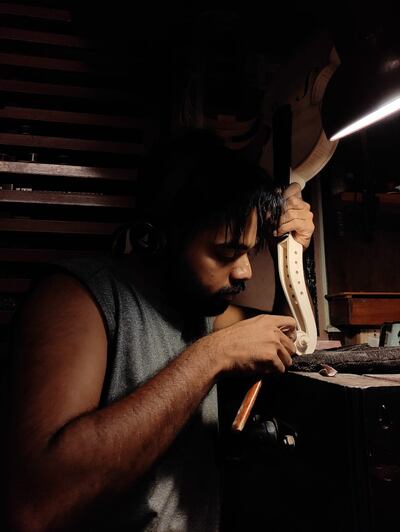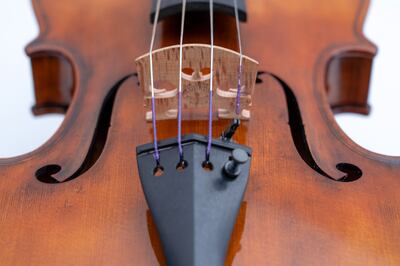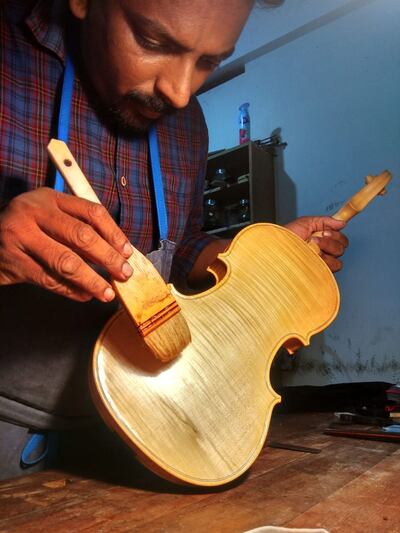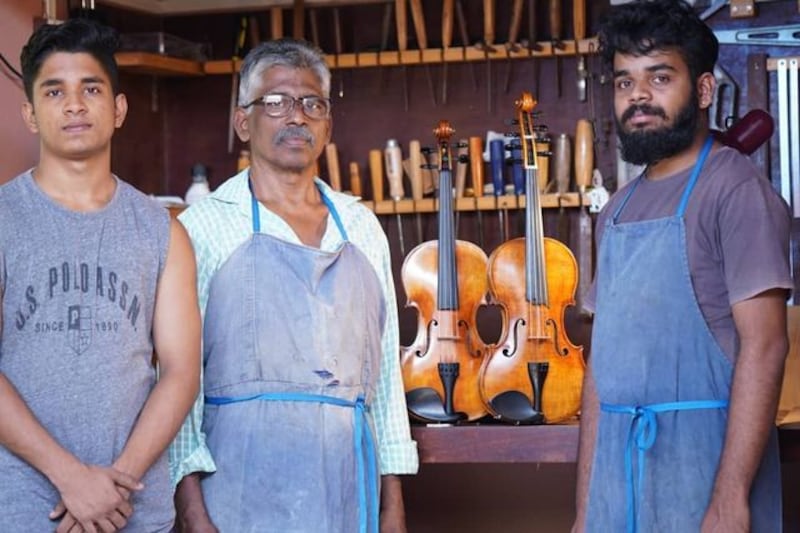Vinay Murali is at work in his small workshop in Chendamangalam, near Kochi in Kerala. The space is lined with tools and violins in the process of being crafted, with a crowded work table littered with tapes, glue and pieces of wood. Vinay’s father E D Murali has been in the business of making and repairing violins since 1982, and heads Fiddle Crafters Luthiers, the family business.
Together with E D and his younger brother Vijay, Vinay repairs and crafts violins and violas, while also producing replicas of high-end European instruments.
The art of making violins has remained almost the same since the 16th century, with luthiers – the name given to those who make and repair stringed instruments with a neck and sound box – building these masterpieces from European maple and spruce wood.
The 17th-century Italian luthiers Antonio Stradivari and Giuseppe “del Gesu” Guarneri, were the pioneers of violin-making and the gold standard in violins is still the 1702 Stradivarius violin, first patented by Antonio Stradivari.
Lalgudi G J R Krishnan, famous violinist and son of legendary maestro Lalgudi Jayaraman, says: “Making its entry into India with the British rule in the 19th century, the violin as an instrument has been an inseparable part of Indian music, contributing immensely in so many ways.
“Unfortunately, though the instrument had entered India, there was no opportunity for the art of violin making and maintenance to find a way to India. Many precious instruments have perished in India under ignorance.”

Most violinists in India used to procure their musical instruments from abroad as the quality of Indian violins was not up to the same standard. Being made from local woods such as jackfruit and teak, they did not have the best tonal qualities. Due a lack of local expertise, many violin players also found that no one could even repair their imported violins properly.
“My father started off trying to repair his friend’s violin. In those days there were no violin makers or repairers in Kerala. After that, a stream of people came to my father to service their instruments. He bought some books from the US, and taught himself how to make and repair a violin,” says Vinay.
Things started to change when the Lalgudi Trust in Chennai – run by the family of the renowned violinist Lalgudi Jayaraman – started running workshops in 2013, bringing international luthiers like James Wimmer from the US, and training craftsmen to craft replicas of the iconic Italian violins. The Lalgudi Trust provided the participants with the same tools that were used in the industry in Germany free of charge, on top of a stipend.
“Through Violin Wise, an intense and extensive free annual workshop organised by Lalgudi Trust for five years under my leadership, we have today four international standard craftsmen who cannot only make quality violins but also maintain and repair any string instrument. Many aspiring craftsmen joined this workshop year after year but only four have graduated”, Krishnan tells The National.

The workshops helped Vinay and his brother Vijay to get access to better tools and techniques to perfect their art. The father-sons team use high-grade European maple and spruce woods, which have been seasoned for up to 15 years, to build the body, as their acoustic qualities are better and the wood is dense and free from defects.
Meanwhile, they use ebony hardwood from India and Sri Lanka for the pegs, tailpieces and end pins. Usually strings, bows and cases are imported from Germany or Singapore.
“Hand crafting a violin is a process that requires dexterity, detailing and high precision,” explains Vinay. “There are as many as 70 pieces of wood and every single part is measured and aligned. Even a difference of one millimetre can affect the sound.”
It takes more than 300 hours for him to craft a Murali family violin. They glue the pieces of wood together using a natural glue made from animal bones so that the violins can be dismantled easily for repairs. They varnish them carefully using home-made tree sap cooked in vegetable oil.
Elsewhere, Renjith Leela Chandran, 36, from Valakudda village in Kerala, sits at his workbench in Chennai, with chisels, gouges, knives, scrapers and callipers hanging on the wall in front of him as he shapes the body of a violin. He is another craftsman who attended the Lalgudi Trust’s workshop and benefited immensely. Chandran belongs to a family of carpenters and when he started learning to play the violin, he started experimenting with making one.

When he attended the Lalgudi Trust’s workshops from 2015, with master luthier James Wimmer, he learnt to grind tools, repair instruments and also picked up details like how to varnish a violin. Slowly he learnt to make a complete instrument.
Chandran says: “I started a small workshop in 2020, but had to close it during the pandemic. In 2022 I moved to Chennai and set up a violin-making workshop. I use Bosnian maple and German spruce for the violins. Bows and strings are imported. I now have orders for handmade violins as well as restoring and repairing old ones.” More than anything else, his evolution from carpenter to violin maker has given him respectability, he says.
The violins made by the Muralis and Chandran's are customised and built only for specific musicians, and vary according to whether they are a Carnatic classical or Hindustani classical musician. Carnatic musicians usually sit on the ground and rest their violins on their legs, so the neck has to be extended.
Their clientele spreads only by word of mouth and their manufacture is exclusive. Most of their violins are sold at prices starting around 1,75,000 rupees (Dh7,780).
“No two of the violins that I craft are alike – each has its own character and tonal qualities and can last even three generations,” says Chandran. “A well-made violin’s value only increases as the years go by – provided you take care of it properly.”






